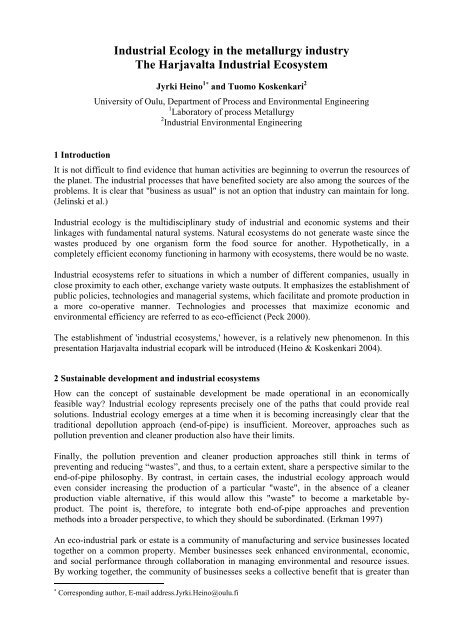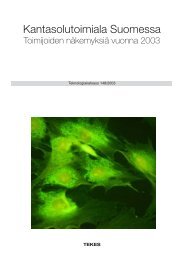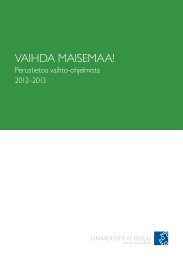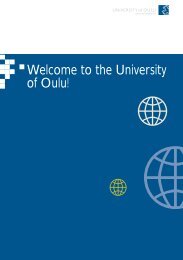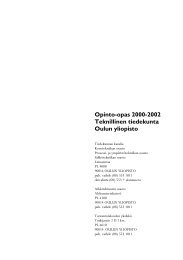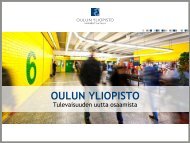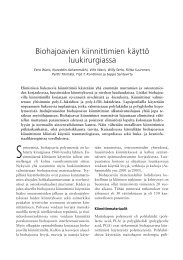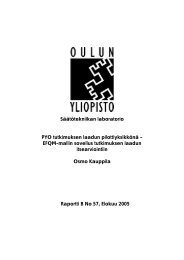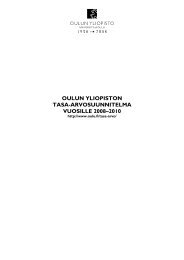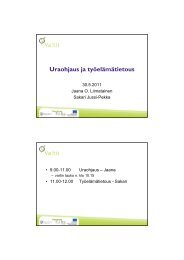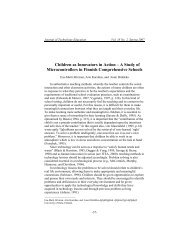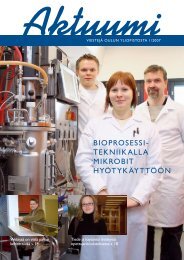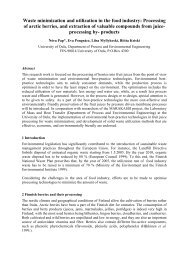Industrial Ecology in the metallurgy industry The Harjavalta ... - Oulu
Industrial Ecology in the metallurgy industry The Harjavalta ... - Oulu
Industrial Ecology in the metallurgy industry The Harjavalta ... - Oulu
Create successful ePaper yourself
Turn your PDF publications into a flip-book with our unique Google optimized e-Paper software.
<strong>Industrial</strong> <strong>Ecology</strong> <strong>in</strong> <strong>the</strong> <strong>metallurgy</strong> <strong>in</strong>dustry<br />
<strong>The</strong> <strong>Harjavalta</strong> <strong>Industrial</strong> Ecosystem<br />
Jyrki He<strong>in</strong>o 1∗ and Tuomo Koskenkari 2<br />
University of <strong>Oulu</strong>, Department of Process and Environmental Eng<strong>in</strong>eer<strong>in</strong>g<br />
1 Laboratory of process Metallurgy<br />
2 <strong>Industrial</strong> Environmental Eng<strong>in</strong>eer<strong>in</strong>g<br />
1 Introduction<br />
It is not difficult to f<strong>in</strong>d evidence that human activities are beg<strong>in</strong>n<strong>in</strong>g to overrun <strong>the</strong> resources of<br />
<strong>the</strong> planet. <strong>The</strong> <strong>in</strong>dustrial processes that have benefited society are also among <strong>the</strong> sources of <strong>the</strong><br />
problems. It is clear that "bus<strong>in</strong>ess as usual" is not an option that <strong>in</strong>dustry can ma<strong>in</strong>ta<strong>in</strong> for long.<br />
(Jel<strong>in</strong>ski et al.)<br />
<strong>Industrial</strong> ecology is <strong>the</strong> multidiscipl<strong>in</strong>ary study of <strong>in</strong>dustrial and economic systems and <strong>the</strong>ir<br />
l<strong>in</strong>kages with fundamental natural systems. Natural ecosystems do not generate waste s<strong>in</strong>ce <strong>the</strong><br />
wastes produced by one organism form <strong>the</strong> food source for ano<strong>the</strong>r. Hypo<strong>the</strong>tically, <strong>in</strong> a<br />
completely efficient economy function<strong>in</strong>g <strong>in</strong> harmony with ecosystems, <strong>the</strong>re would be no waste.<br />
<strong>Industrial</strong> ecosystems refer to situations <strong>in</strong> which a number of different companies, usually <strong>in</strong><br />
close proximity to each o<strong>the</strong>r, exchange variety waste outputs. It emphasizes <strong>the</strong> establishment of<br />
public policies, technologies and managerial systems, which facilitate and promote production <strong>in</strong><br />
a more co-operative manner. Technologies and processes that maximize economic and<br />
environmental efficiency are referred to as eco-efficienct (Peck 2000).<br />
<strong>The</strong> establishment of '<strong>in</strong>dustrial ecosystems,' however, is a relatively new phenomenon. In this<br />
presentation <strong>Harjavalta</strong> <strong>in</strong>dustrial ecopark will be <strong>in</strong>troduced (He<strong>in</strong>o & Koskenkari 2004).<br />
2 Susta<strong>in</strong>able development and <strong>in</strong>dustrial ecosystems<br />
How can <strong>the</strong> concept of susta<strong>in</strong>able development be made operational <strong>in</strong> an economically<br />
feasible way? <strong>Industrial</strong> ecology represents precisely one of <strong>the</strong> paths that could provide real<br />
solutions. <strong>Industrial</strong> ecology emerges at a time when it is becom<strong>in</strong>g <strong>in</strong>creas<strong>in</strong>gly clear that <strong>the</strong><br />
traditional depollution approach (end-of-pipe) is <strong>in</strong>sufficient. Moreover, approaches such as<br />
pollution prevention and cleaner production also have <strong>the</strong>ir limits.<br />
F<strong>in</strong>ally, <strong>the</strong> pollution prevention and cleaner production approaches still th<strong>in</strong>k <strong>in</strong> terms of<br />
prevent<strong>in</strong>g and reduc<strong>in</strong>g “wastes”, and thus, to a certa<strong>in</strong> extent, share a perspective similar to <strong>the</strong><br />
end-of-pipe philosophy. By contrast, <strong>in</strong> certa<strong>in</strong> cases, <strong>the</strong> <strong>in</strong>dustrial ecology approach would<br />
even consider <strong>in</strong>creas<strong>in</strong>g <strong>the</strong> production of a particular "waste", <strong>in</strong> <strong>the</strong> absence of a cleaner<br />
production viable alternative, if this would allow this "waste" to become a marketable byproduct.<br />
<strong>The</strong> po<strong>in</strong>t is, <strong>the</strong>refore, to <strong>in</strong>tegrate both end-of-pipe approaches and prevention<br />
methods <strong>in</strong>to a broader perspective, to which <strong>the</strong>y should be subord<strong>in</strong>ated. (Erkman 1997)<br />
An eco-<strong>in</strong>dustrial park or estate is a community of manufactur<strong>in</strong>g and service bus<strong>in</strong>esses located<br />
toge<strong>the</strong>r on a common property. Member bus<strong>in</strong>esses seek enhanced environmental, economic,<br />
and social performance through collaboration <strong>in</strong> manag<strong>in</strong>g environmental and resource issues.<br />
By work<strong>in</strong>g toge<strong>the</strong>r, <strong>the</strong> community of bus<strong>in</strong>esses seeks a collective benefit that is greater than<br />
∗ Correspond<strong>in</strong>g author, E-mail address.Jyrki.He<strong>in</strong>o@oulu.fi
<strong>the</strong> sum of <strong>in</strong>dividual benefits each company would realize by only optimiz<strong>in</strong>g its <strong>in</strong>dividual<br />
performance (Lowe, et al. 2003). Accord<strong>in</strong>g to Lowe (2003), to be a real eco-<strong>in</strong>dustrial park,<br />
development must be more than:<br />
‣ A s<strong>in</strong>gle by-product exchange or network of exchanges;<br />
‣ A recycl<strong>in</strong>g bus<strong>in</strong>ess cluster;<br />
‣ A collection of environmental technology companies;<br />
‣ A collection of companies mak<strong>in</strong>g “green” products;<br />
‣ An <strong>in</strong>dustrial park designed around a s<strong>in</strong>gle environmental <strong>the</strong>me; A park with<br />
environmentally friendly <strong>in</strong>frastructure or construction; or<br />
‣ A mixed-use development (<strong>in</strong>dustrial, commercial, and residential).<br />
3 <strong>The</strong> history of <strong>Harjavalta</strong> <strong>in</strong>dustrial area<br />
Outokumpu copper plant <strong>in</strong> sou<strong>the</strong>rn F<strong>in</strong>land was moved from Imatra to <strong>Harjavalta</strong> because of<br />
World War II. After <strong>the</strong> war, F<strong>in</strong>land suffered from severe energy shortage. This shortage made<br />
<strong>the</strong> Outokumpu metallurgists and eng<strong>in</strong>eers resort to <strong>the</strong> <strong>the</strong>ory of autogenous smelt<strong>in</strong>g, whereby<br />
<strong>the</strong> heat produced by oxidiz<strong>in</strong>g metal concentrates is used to ma<strong>in</strong>ta<strong>in</strong> <strong>the</strong> smelt<strong>in</strong>g process, and<br />
turned that <strong>in</strong>to commercial reality. (Paatela 2002)<br />
<strong>The</strong> first ever copper flash smelter went <strong>in</strong>to operation <strong>in</strong> <strong>Harjavalta</strong>, F<strong>in</strong>land, <strong>in</strong> 1949. <strong>The</strong><br />
technology has s<strong>in</strong>ce been applied to nickel concentrates. Flash smelt<strong>in</strong>g stands as Outokumpu’s<br />
greatest technological achievement. Today, 46 licensees <strong>in</strong> all five cont<strong>in</strong>ents evidence its<br />
success. <strong>The</strong> technology is used to produce about 50 % of <strong>the</strong> world’s primary copper and 30 %<br />
of <strong>the</strong> nickel. (Paatela 2002)<br />
Copper and nickel flash smelters form <strong>the</strong> heart of <strong>the</strong> <strong>Harjavalta</strong> <strong>in</strong>dustrial ecopark consist of<br />
thirteen different firms. <strong>Harjavalta</strong> Copper Oy, OMG <strong>Harjavalta</strong> Nickel Oy, Kemira GrowHow<br />
Oy <strong>Harjavalta</strong> plants and Kemira Oyj <strong>Harjavalta</strong>, Por<strong>in</strong> Lämpövoima Oy, Oy AGA Ab, ABB,<br />
Amica, Engel, SOL, Säkkiväl<strong>in</strong>e, Lassila & Tikanoja ja Valtasiirto. Table 1 presents <strong>the</strong> most<br />
important milestones of <strong>the</strong> <strong>Harjavalta</strong> <strong>in</strong>dustarial area (He<strong>in</strong>o & Koskenkari s. 9)<br />
Table 1. <strong>The</strong> history of <strong>Harjavalta</strong> <strong>in</strong>dustrial area (He<strong>in</strong>o & Koskenkari).<br />
1944 Outokumpu copper factory is moved from Imatra to <strong>Harjavalta</strong>.<br />
1945 <strong>The</strong> start up of <strong>the</strong> Outokumpu copper factory<br />
1947 <strong>The</strong> start up of <strong>the</strong> Kemira sulfuric acid plant<br />
1949 Outokumpu copper flash smelter goes <strong>in</strong>to operation<br />
1959 Outokumpu nickel flash smelter goes <strong>in</strong>to operation<br />
1960 Outokumpu nickel cathodes production starts<br />
1971 <strong>The</strong> start up of <strong>the</strong> oxygen plant<br />
1995 <strong>The</strong> AGA hydrogen plant start-up<br />
1995 <strong>The</strong> direct Outokumpu nickel process (DON)<br />
2000 OMG <strong>Harjavalta</strong> Nickel Oy is founded<br />
2000 Por<strong>in</strong> Lämpövoima Oy starts <strong>the</strong> energy production<br />
2002 OMG <strong>Harjavalta</strong> Nickel Oy starts <strong>the</strong> nickel chemical production<br />
2004 New Boliden buys <strong>the</strong> copper and nickel smelters<br />
2004 <strong>Harjavalta</strong> Copper Oy is founded
4 <strong>The</strong> <strong>Harjavalta</strong> <strong>in</strong>dustrial area<br />
<strong>The</strong> area of <strong>the</strong> <strong>Harjavalta</strong> <strong>Industrial</strong> Ecopark is almost 300 hectares. In this locale, over 1000<br />
employees are employed. As well as <strong>the</strong> ma<strong>in</strong> firms <strong>in</strong> <strong>the</strong> area, <strong>the</strong>re are also over 100<br />
subcontractors function<strong>in</strong>g. In this section, <strong>the</strong> five process <strong>in</strong>dustry firms, <strong>Harjavalta</strong> Copper<br />
Oy, OMG <strong>Harjavalta</strong> Nickel Oy, Kemira, Por<strong>in</strong> lämpövoimala Oy <strong>Harjavalta</strong> unit and Oy AGA<br />
Ab <strong>Harjavalta</strong> unit, are <strong>in</strong>troduced.<br />
4.1 <strong>Harjavalta</strong> Copper copper and nickel flash smelters<br />
Outokumpu flash smelt<strong>in</strong>g is a pyrometallurgical process for smelt<strong>in</strong>g copper sulphide<br />
concentrates (Figure 1) (Riekkola-Vanhanen 1999, s. 16 – 17).<br />
Figure 1 <strong>Harjavalta</strong> copper smelter flow sheet (Riekkola-Vanhanen 1999, s. 17)
Besides <strong>the</strong> primary metals of copper and iron, <strong>the</strong> concentrate aslo <strong>in</strong>cludes smaller amounts of<br />
different heavy metals (Ni, Zn, Pb, Co, As, Sb, Bi, Ag and Au). In <strong>the</strong> case of copper, <strong>the</strong> general<br />
concept of process is: f<strong>in</strong>e dry copper sulphide concentrate and quartz sand as flux are blown<br />
<strong>in</strong>to a hot hearth furnace with oxygen (<strong>in</strong>dustrial), oxygen-enriched air. <strong>The</strong> products are a Cu-<br />
Fe-S matte, SO 2 enriched off-gases, and slag. <strong>The</strong> ma<strong>in</strong> reaction is:<br />
2 CuFeS 2 + 4O 2 ⇔ Cu 2 S + 2FeO + 3SO 2 (1)<br />
<strong>The</strong> matte is fur<strong>the</strong>r processed <strong>in</strong> a Peirce-Smith converter to obta<strong>in</strong> <strong>the</strong> metallic copper. <strong>The</strong> slag<br />
is treated to recover its 2 % copper content. <strong>The</strong> off-gas conta<strong>in</strong>s about 10 - 75 percent by<br />
volume SO 2 . Heat<strong>in</strong>g needed for smelt<strong>in</strong>g is obta<strong>in</strong>ed from <strong>the</strong> exo<strong>the</strong>rmic reaction of oxidiz<strong>in</strong>g<br />
<strong>the</strong> Fe and S <strong>in</strong> <strong>the</strong> feed. <strong>The</strong> reaction is (Luomala 2002);<br />
[ FeS] + 3 O = ( FeO)<br />
+ SO<br />
2 2 2 (2)<br />
<strong>The</strong> iron forms with quartz fayalite slag:<br />
2FeO + SiO2<br />
= 2FeO ⋅ SiO2<br />
(3)<br />
<strong>The</strong> SO 2 is recovered and treated to make ei<strong>the</strong>r SO 2 or H 2 SO 4 . <strong>The</strong> recovery of by-products and<br />
recycl<strong>in</strong>g of dust and wastewater have an important effect on <strong>the</strong> environment, because dusts and<br />
wastewater conta<strong>in</strong> quite a lot of heavy metals.<br />
<strong>The</strong> <strong>Harjavalta</strong> Copper DON process elim<strong>in</strong>ates <strong>the</strong> convert<strong>in</strong>g stage altoge<strong>the</strong>r and thus greatly<br />
simplifies <strong>the</strong> nickel process. High-grade matte is produced us<strong>in</strong>g only <strong>the</strong> flash smelt<strong>in</strong>g furnace<br />
and electric furnace – without Peirce-Smith converters. <strong>The</strong> SO 2 is recovered and treated <strong>in</strong> <strong>the</strong><br />
same sulphuric acid plant as is <strong>the</strong> gas from copper smelter. <strong>The</strong> elim<strong>in</strong>ation of converters<br />
reduces <strong>the</strong> <strong>in</strong>vestment, operat<strong>in</strong>g and ma<strong>in</strong>tenance costs significantly. <strong>The</strong> nickel flash smelt<strong>in</strong>g<br />
flow sheet is shown <strong>in</strong> Figure 2.<br />
Figure 2 <strong>The</strong> nickel flash smelt<strong>in</strong>g flow sheet.
4.2 OMG <strong>Harjavalta</strong> Nickel Oy<br />
<strong>The</strong> high-grade matte is leached, o<strong>the</strong>r metals are separated from <strong>the</strong> solution, and <strong>the</strong> rema<strong>in</strong><strong>in</strong>g<br />
nickel solution is treated to produce both nickel powder and cathode nickel by electro w<strong>in</strong>n<strong>in</strong>g.<br />
<strong>The</strong> nickel production hydrometallurgical process flow sheet is shown <strong>in</strong> Figure 3 (Pääkkönen &<br />
Mattelmäki 1996)<br />
4.3 Pori Lämpövoima Oy <strong>Harjavalta</strong> unit<br />
Pori Lämpövoima Oy utilizes <strong>the</strong> heat of <strong>the</strong> exo<strong>the</strong>rmic copper and nickel flash smelt<strong>in</strong>g<br />
process. <strong>The</strong> energy is captured by <strong>the</strong> waste heat boilers as is shown <strong>in</strong> Figures 1 and 2. <strong>The</strong><br />
reaction heats formed <strong>in</strong> <strong>the</strong> sulphuric acid plant through <strong>the</strong> reactions 4 and 5 is also utilized by<br />
Por<strong>in</strong> Lämpövoima Oy (He<strong>in</strong>o 2002):<br />
SO 2 + 0,5 O 2 ⇔ SO 3 ∆H° = -99,0 kJ/mol (4)<br />
SO 3 (g) + H 2 O(l) ⇔ H 2 SO 4 (l) ∆H° = -132,5 kJ/mol (5)<br />
Figure 3 <strong>The</strong> nickel production hydrometallurgical process flow sheet (Pääkkönen &<br />
Mattelmäki 1996).<br />
4.4 Oy AGA Ab <strong>Harjavalta</strong> Unit<br />
<strong>The</strong> Oy Aga Ab <strong>Harjavalta</strong> unit manufactures oxygen, nitrogen and argon by air distillation. <strong>The</strong><br />
hydrogen is made from <strong>in</strong>dustrial gasol<strong>in</strong>e. <strong>The</strong> oxygen, nitrogen, argon and hydrogen are used<br />
<strong>in</strong> <strong>the</strong> manufactur<strong>in</strong>g of copper and nickel at Harjavalt Copper and OMG <strong>Harjavalta</strong> Nickel.<br />
Parts of <strong>the</strong> products are used by <strong>the</strong> o<strong>the</strong>r plants outside of <strong>in</strong>dustrial area.
4.5 Kemira <strong>Harjavalta</strong> unit<br />
<strong>The</strong> ma<strong>in</strong> product of <strong>the</strong> Kemira <strong>Harjavalta</strong> unit is alum<strong>in</strong>ium sulfate made from sulfuric acid<br />
and alum<strong>in</strong>ium hydrate (Al(OH) 3 ). <strong>The</strong> agency of <strong>the</strong> sulfuric acid and liquid sulfur dioxide is<br />
also part of Kemira’s bus<strong>in</strong>ess. As well, Kemira manufactures urea phosphate, and different<br />
granulated and glasshouse fertilizers. (He<strong>in</strong>o & Koskenkari 2004, s. 25)<br />
5 <strong>The</strong> <strong>Harjavalta</strong> <strong>in</strong>dustrial area as an <strong>in</strong>dustrial ecosystem<br />
This section is based on <strong>the</strong> enquiry which was directed to <strong>the</strong> five firms presented <strong>in</strong> section 4,<br />
and to city of <strong>Harjavalta</strong>. (He<strong>in</strong>o & Koskenkari 2004)<br />
<strong>The</strong> most important advantages of <strong>the</strong> <strong>in</strong>tegration to <strong>the</strong> firms were environmental and recycl<strong>in</strong>g<br />
advantages, image factors and market<strong>in</strong>g, and logistic advantages. <strong>The</strong> network and <strong>the</strong> better<br />
co-operation has also been a very positive development factor. As well, safety actions improved<br />
because of <strong>the</strong> co-operation (He<strong>in</strong>o & Koskenkari 2004, s. 25)<br />
For <strong>the</strong> city of <strong>Harjavalta</strong>, <strong>the</strong> most important advantages of <strong>the</strong> <strong>in</strong>dustrial area are employment,<br />
<strong>in</strong>ternational dimension, <strong>in</strong>tellectual capital and image because of <strong>the</strong> famous firms located <strong>the</strong>re.<br />
(He<strong>in</strong>o & Koskenkari 2004, s. 25)<br />
<strong>The</strong> material and energy change between <strong>the</strong> firms is shown <strong>in</strong> Figure 4 (He<strong>in</strong>o & Koskenkari<br />
2004, s. 31). Extra energy of <strong>the</strong> processes is utilized as electricity, high temperature steam or<br />
heat<strong>in</strong>g energy by <strong>the</strong> process plants or by <strong>the</strong> city of <strong>Harjavalta</strong>, which utilizes <strong>the</strong> energy <strong>in</strong><br />
district heat<strong>in</strong>g.<br />
When consider<strong>in</strong>g <strong>the</strong> <strong>Harjavalta</strong> <strong>in</strong>dustrial area as an <strong>in</strong>dustrial ecosystem, we take <strong>in</strong>to<br />
consideration <strong>the</strong> ecosystem pr<strong>in</strong>ciples roundput, diversity, locality and gradual change, which<br />
are summarized <strong>in</strong> Table 2 (Korhonen 2001). Three of <strong>the</strong> four pr<strong>in</strong>ciples of Korhonen are<br />
fullfilled <strong>in</strong> <strong>the</strong> <strong>Harjavalta</strong> <strong>Industrial</strong> Ecosystem. <strong>The</strong>re are also plans and research work go<strong>in</strong>g on<br />
to improve friendl<strong>in</strong>ess to <strong>the</strong> environment. (<strong>The</strong> grounds for this argumentation are better<br />
expressed <strong>in</strong> <strong>the</strong> oral part of this presentation).<br />
Table 2 Ecosystem pr<strong>in</strong>ciples <strong>in</strong> <strong>in</strong>dustrial ecosystems (Korhonen 2001).<br />
Ecosystem<br />
Roundput<br />
Recycl<strong>in</strong>g of matter<br />
Cascad<strong>in</strong>g energy<br />
Diversity<br />
Biodiversity<br />
Diversity <strong>in</strong> species and organism<br />
Diversity and <strong>in</strong>dependency <strong>in</strong> co-operation<br />
Locality<br />
Utiliz<strong>in</strong>g local resources<br />
Respect<strong>in</strong>g local natural limit<strong>in</strong>g factors<br />
Local <strong>in</strong>dependency, co-operation<br />
Gradual change<br />
Evolution us<strong>in</strong>g solar energy<br />
Evolution through reproduction<br />
Cyclical time, seasonal time<br />
Slow time rates <strong>in</strong> <strong>the</strong> development of system diversity<br />
<strong>Industrial</strong> system<br />
Roundput<br />
Recycl<strong>in</strong>g of mater<br />
Cascad<strong>in</strong>g energy<br />
Diversity<br />
Diversity <strong>in</strong> actors, <strong>in</strong>terdependency and<br />
cooperation<br />
Diversity <strong>in</strong> <strong>in</strong>dustrial <strong>in</strong> put, output<br />
Locality<br />
Utiliz<strong>in</strong>g local resources, wastes<br />
Respect<strong>in</strong>g local natural limit<strong>in</strong>g factors<br />
Co-operation between local actors<br />
Gradual change<br />
Us<strong>in</strong>g waste material and energy, renewable<br />
resources<br />
Gradual development of <strong>the</strong> system diversity
Figure 4 <strong>The</strong> material and energy change between <strong>the</strong> firms <strong>in</strong> <strong>Harjavalta</strong> <strong>in</strong>dustrial area (He<strong>in</strong>o<br />
& Koskenkari 2004, s. 31).
References<br />
Erkman, S. <strong>Industrial</strong> <strong>Ecology</strong>: A Historical View. Geneva 1997. Prepr<strong>in</strong>t, to appear <strong>in</strong> Journal<br />
of Cleaner Production. 16 s.<br />
He<strong>in</strong>o, J. Kupar<strong>in</strong> ja nikkel<strong>in</strong> valmistuksen ympäristöasiat ja kierrätys. In: Heikk<strong>in</strong>en, E.-P. &<br />
He<strong>in</strong>o, J. Metallurg<strong>in</strong> hyvä tietää: Värimetallien valmistus. <strong>Oulu</strong> 2002. <strong>Oulu</strong>n yliopisto, s. 30<br />
- 37.<br />
He<strong>in</strong>o, J. & Koskenkari, T. Harjavallan Suurteollisuuspuisto Teollisena ekosysteem<strong>in</strong>ä. <strong>Oulu</strong><br />
2004. <strong>Oulu</strong>n yliopisto. 44 s.<br />
Jel<strong>in</strong>ski, l.W., Graedel, T.E., Laudise, R.A., Mccall, D.W. & Patel, C. K. N. <strong>Industrial</strong> <strong>Ecology</strong>:<br />
Concepts and Approaches. AT&t BEEL Laboratories. Murray Hill, NJ 07974.<br />
Korhonen, J. Four ecosystem pr<strong>in</strong>ciples for an <strong>in</strong>dustrial ecosystem. Journal of Cleaner<br />
Production 9(2001), s. 253 – 259.<br />
Lowe, E. Introduction to Eco-<strong>Industrial</strong> Parks and Networks. 8.9.2003.<br />
Lowe E., Moran S., & Holmes D. Eco-<strong>Industrial</strong> Parks. 13.10.2003<br />
Luomala, M. Kupar<strong>in</strong> liekkisulatusmenetelmä ja metallisen kupar<strong>in</strong> elektrolyytt<strong>in</strong>en raff<strong>in</strong>o<strong>in</strong>ti.<br />
In: Heikk<strong>in</strong>en, E.-P. & He<strong>in</strong>o, J. (toim.) Metallurg<strong>in</strong> hyvä tietää: Värimetallien valmistus.<br />
<strong>Oulu</strong> 2002. <strong>Oulu</strong>n yliopisto, s. 6 – 18.<br />
Paatela, E. Outokumpu Flash Smelt<strong>in</strong>g Process received ASM Historical Landmark Award.<br />
Hels<strong>in</strong>ki 2002. 31.05.2004<br />
Peck, S. W. From <strong>the</strong>ory to practice. 20.5.2000.<br />
Pääkkönen, E. & Mattelmäki, E. <strong>The</strong> Direct Outokumpu Nickel Smelt<strong>in</strong>g (DON) Process and <strong>the</strong><br />
<strong>Harjavalta</strong> Expansion. Nickel’ 96. 27 – 29.11.1996, Kalgoorlie. 7 s.<br />
Riekkola-Vanhanen, M. F<strong>in</strong>nish expert report on best available techniques <strong>in</strong> copper production<br />
and by-production of precious metals. Hels<strong>in</strong>ki 1999, Oy Edita Bb. 80 s.<br />
Article reference:<br />
He<strong>in</strong>o J & Koskenkari T. (2004) <strong>Industrial</strong> <strong>Ecology</strong> and <strong>the</strong> <strong>metallurgy</strong> <strong>in</strong>dustry. <strong>The</strong> <strong>Harjavalta</strong><br />
<strong>in</strong>dustrial ecosystem. In: Pongrácz E. (ed.): Proceed<strong>in</strong>gs of <strong>the</strong> Waste M<strong>in</strong>imization and<br />
Resources Use Optimization Conference. June 10 th 2004, University of <strong>Oulu</strong>, F<strong>in</strong>land. <strong>Oulu</strong><br />
University Press: <strong>Oulu</strong>. p.143-151.


